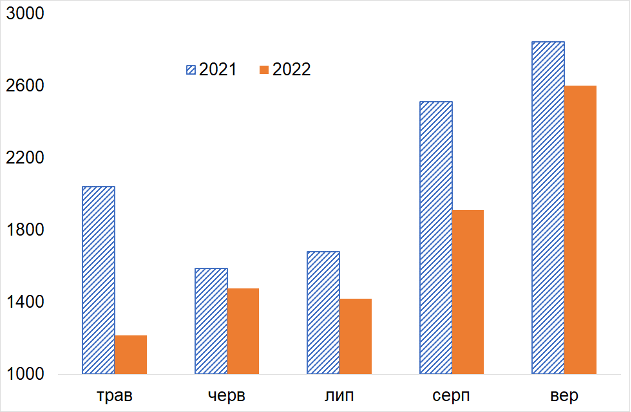Short-term changes in the accounts of foreign economic activity provide clear signals of the nearest prospects of the national economy. In our previous review of Ukraine's balance of payments, we focused on large-scale changes in the spring of 2022 in the structure of the foreign economic environment caused by the war. Here we will turn to the payments balance structure for the first three quarters, as we can already talk about a certain stabilisation of foreign economic dynamics, which may witness the adaptability of the country's economic environment to the war losses.
As indicated, the vast majority of experts expects a fall in the country's GDP by a third in 2022 (which is much better than the estimates in the first months of the aggression), and the good news (as much as it is possible in the current situation) is that the events and processes at the front are quickly reflected in the balance of payments — the liberation of the country provides a chance for growth of production, exports and, ultimately, the economy in general.
According to the NBU data for 9 months of 2022, the current account surplus hit $8.5 billion (in January-September 2021, there was a deficit of $1.5 billion). That is, while normally, Ukraine has to spend reserves to finance the trade deficit, today the current account presents a source of replenishment of the reserves. As we mentioned, such changes became possible thanks to the unprecedented help of the Western partners financing Ukraine’s needs not only in the military and security sectors, but also in the social and economic domains. In particular, while in 9 months of 2021 the balance of the so-called secondary income (including grants and aid) amounted to $3.4 billion, in the same period of 2022, it made almost $17 billion.
Let us take a look at some features of the trade balance over the three quarters of the year (table "Volume of Ukrainian commodity exports").
Volume of Ukrainian commodity exports, $ million, January-September
|
2020 |
2021 |
2022 |
|
|
Total |
32101 |
44580 |
30511 |
|
Foodstuffs and raw materials for their production |
15452 |
17839 |
16002 |
|
Mineral products |
3428 |
6663 |
3591 |
|
Ferrous and nonferrous metals and items therefrom |
6528 |
11571 |
4991 |
(1). The drop in exports of goods by almost 32% (in 2022, compared to 2021) is not a collapse and fully correlates with the mentioned forecast of the GDP drop by a third. What is more unexpected is that the volume of exports in 2022 (and to a large extent its structure) is quite close to that in 2020, in the conditions of the coronavirus (a year of peace characterised by significant restrictions, including in international trade).
The following summarised assumption is necessary here. Ukraine was not ready for the pandemic and the invasion alike. The country did not have reliable strategic reserves, the leadership was sure that it would dissolve until the last day (before the pandemic and the aggression). It may sound bitter but we can say today that Ukraine was "lucky" that the pandemic came to the country two years before the Russian aggression, because no matter how bitter the experience of the coronavirus crisis was, it helped to quickly realise the possible consequences of the Russian invasion, to manage rationally, to use the limited resources efficiently in order to repel the invaders. That is, the coronavirus crisis played a certain "positive" role for the national economy, as it showed the way out of the economic crisis under force majeure (in particular, forced restrictions).
(2). Another feature of the trade balance for 9 months is that the exports of agricultural produce fell by only about 10% (all exports — by more than 30%) and in recent months have somewhat caught up with the previous year (diagram "Exports of foodstuffs and raw materials for their production"). Such a relatively small decrease may indicate that the domestic agricultural and food sectors are finding their ways to the foreign markets, including thanks to the opening of Western markets in the process of the European integration. The "grain deal" also helped. Therefore, if it is extended, we may expect further levelling of agricultural exports.
Exports of foodstuffs and raw materials for their production, $ million

May June July Aug Sep
(3). The results of foreign trade as of September 2022, surprisingly, turn out to be quite close to the results of the Razumkov Centre public opinion poll about household assessments of their well-being. We will remind you that the estimates for September 2022 regarding the well-being of families turned out to be quite close to the corresponding estimates of well-being two years ago — in September 2020. Somewhat higher estimates were observed in 2021, in the conditions of peaceful positive economic dynamics.
The table "Volume of Ukrainian commodity exports" shows that the trade balance in 2022 looks even slightly better than expected (and compared to 2020), which also correlates with the poll on household well-being.
A coincidence? Rather, it proves that Ukrainians have already learned to overcome force majeure and troubles, are ready to work tirelessly, multiplying efforts to restore their country and improve the well-being of their families.




